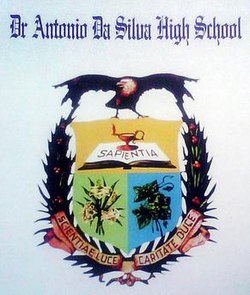A junior college is a type of post-secondary institution that offers vocational and academic training that is designed to prepare students for either skilled trades and technical occupations or support roles in professions such as engineering, accountancy, business administration, nursing, medicine, architecture, and criminology. Often times, those types of colleges offer 2-year associate's degrees that are intended for students that want to later transfer to a 4-year bachelor's degree to finish their undergraduate education, pending adequate grades. Students typically attend those types of colleges for 1-3 years, which is also dependent on the country.
Hansraj Morarji Public School is a combined primary, junior and senior school in Mumbai, India. It was founded in 1939 by the Bai Kabibai and Hansraj Morarji Trust. The foundation stone was laid by Sardar Patel. The school was earlier an all-boys school but now admits girls.

Dadar ([d̪aːd̪əɾ]) is a densely populated residential and shopping neighbourhood in Mumbai. It is also a prominent railway and bus service hub with local and national connectivity. It is Mumbai’s first planned area and it's a hub for the city's Marathi culture.

Elphinstone College is one of the constituent colleges of Dr. Homi Bhabha State University, a state cluster university. Established in 1856, it is one of the oldest colleges in Mumbai. It played a major role in shaping and developing the educational landscape of the city. It also played a pivotal role in the inception of the University of Mumbai.

The Holy Family High School is a private Catholic primary and secondary school for boys located in the suburb of East Andheri in Mumbai, in the state of Maharashtra, India. While the school is primarily English-medium, there is also a smaller Marathi-medium section that runs in parallel from the fifth to the tenth standard. The school now also has a junior college named Holy Family Junior College for 11th and 12th grade HSC students. The school is located near MIDC, Andheri East, Mumbai - 400093, Opposite MIDC building.
The New Era High School is located in Panchgani, a hill station town known as an educational centre, in the state of Maharashtra, India. It is a private co-educational international Baháʼí school, drawing students from all over the world and is under the supervision of the National Spiritual Assembly of the Baháʼís of India.

Doongasree Gangji Ruparel College of Arts, Science and Commerce, known as Ruparel College, is an undergraduate college in Matunga, Mumbai, Maharashtra, India. It is run by the Modern Education Society, Pune and is affiliated with the University of Mumbai.

Walchand Institute of Technology (WIT), established in 1983, is the oldest engineering college in Solapur, India. Now it is first autonomous Engineering institute of Solapur. WIT is managed by Shri Aillak Pannalal Digambar Jain Pathashala Trust and is named after Seth Walchand Hirachand, one of India's pioneers of industrial development.
Rajarshi Shahu Mahavidyalaya, Latur (R.S.M.L.) is a higher secondary education institution in the Latur, Maharashtra, India. The college was a pioneer in the development of the "Latur Pattern", which has been adopted and implemented by many other colleges across the state.
The Secondary School Leaving Certificate is a certification obtained by a student on successful completion of an examination at the end of study at the secondary schooling level in India. The SSLC is obtained on passing the grade 10 public examination, which is commonly referred to as 'class 10 board examinations' in India. SSLC is a common eligibility examination popular in many states in India, especially Kerala, Karnataka, and Tamil Nadu. The SSLC is also called Secondary School Certificate (SSC) in Andhra Pradesh, Telangana, Maharashtra and also as High School Certificate (HSC) in Madhya Pradesh and also as Matriculation in many states of India.
In the Indian education system of some Indian states, the pre-university course (PUC) or pre-degree course (PDC) is referred to as intermediate or +2 course, which is a two-year senior secondary education course that succeeds the tenth grade and precedes to the completion of an Senior Secondary Course. The First Year of the PUC is commonly referred to as 1st PUC or Class 11th,, and the Second Year of the PUC as 2nd PUC or Class 12th. A college which offers the PUC is simply known as a 'PU college' or 'Intermediate College' which is also referred to as junior college.

The Chatrapati Shivaji Maharaj Park Residential Zone is a precinct consisting of 187 residential buildings that were built as part of the Chatrapati Shivaji Maharaj Park scheme in Dadar, Mumbai. Most of the buildings in this residential locality were constructed in the early 1900s during British colonial rule in India, as a result of which many buildings here exhibit aspects of British architecture.
Modern education was introduced to Maharashtra region during the 19th century by British colonial administration. Census of 2011 showed literacy rates in the state for males and females were around 78% and 67% respectively. Education at different levels in the state is provided by the state, government supported charities, or private institutions. There are also a number of institutes offering vocational training.

Vinod Sridhar Tawde is an Indian politician from Maharashtra and a senior leader of the Bharatiya Janata Party (BJP). He was the General Secretary for Maharashtra unit of the party, President for Mumbai, All India National Executive Council Member and a key member of co-ordination Committee of the BJP for the 12th and 13th Lok Sabha Election.
Soonabai Pestonji Hakimji High School is a school located in Bordi, Maharashtra, India. Established in 1920
National Education Society's High School and Junior College is commonly known as NES High School, which is located in suburb of Mumbai, in Bhandup. It is the first institute of National Education Trust. The school was established on 14 April 1963, by the President of the school Dr. R Varadarajan. The school is affiliated to SSC and HSC board.










